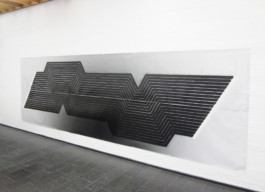Copy that (Stella / Wool)
Selected paintings of Frank Stella and Christopher Wool were reconstructed by means of cameraless photography. In a performative act, a precisely planned and studied choreography the particular processes and gestures of these paintings are copied and reenacted with the aid of photogram and luminogram techniques employing i.a. light stamps, stencils and torch lights. While the resulting photographs resemble reproductions of the originals, they are indeed recreations, undermining the assumption that analogue photography requires the presence of a physical object. In an extended process of exposure the original work is repeated across physical and temporal distance. The difference between the painterly model and the light-painterly reconstruction reveals what László Moholy-Nagy called 'facture of light': 'the sensually perceptible impact of the work process, which becomes apparent in the material'. (László Moholy-Nagy, From Material to Architecture, Munich 1929, p. 33.)
Tomlinson Court Park (F. Stella), luminogram, silver gelatine print (in two parts), 240 x 300 cm, 2012 (detail)

Tomlinson Court Park (F. Stella), luminogram, silver gelatine print (in two parts), 240 x 300 cm, 2012

Die Fahne hoch! (F. Stella), luminogram, silver gelatine print (in four parts), 325 x 200 cm, 2012

De la nada Vida a la nada Muerte (F. Stella), luminogram, silver gelatine print (in two parts), 254 x 756 cm, 2012. Kunsthalle Bremerhaven, 2012


Sabra I (F. Stella), photogram, silver gelatine print (in two parts), 254 x 254 cm, 2012

Takht-i-Sulayman I (F. Stella), photogram, silver gelatine print (in four parts), 250,5 x 484 cm, 2012

BLUE FOOL 1990 (C. Wool), photogram, C-print, 164 x 127 cm, 2015

Untitled 1991 (C. Wool), leaves, photogram, C-print, 164 x 127 cm, 2015

He Said She Said 2001 (C. Wool), luminogram, C-print, 164 x 127 cm, 2015

Untitled 1995 (C. Wool), black, luminogram, silver gelatine print, 164 x 127 cm, 2015


